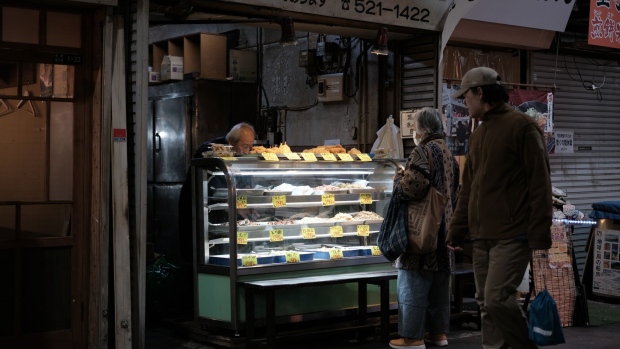Jan 18, 2024
Japan’s Inflation Cools for Second Month Ahead of BOJ Meeting
, Bloomberg News

(Bloomberg) -- Japan’s latest inflation report gives the Bank of Japan another reason to wait beyond next week’s meeting before ending the negative rate policy, while also adding to the case for a hike in coming months.
Growth in consumer prices excluding fresh food slowed to 2.3% in December from a year earlier, matching consensus, the internal affairs ministry reported Friday. Deeper drops in electricity and gas prices and a slower pace of gains for processed food weighed on the index.
For a second month, prices for services rose 2.3%, the fastest pace in three decades excluding periods distorted by sales tax hikes.
The data support the view that there’s no pressing need for the BOJ to rush into making its first rate hike since 2007 at its January meeting, with April touted by many economists as the most likely month.
Friday’s data are the latest indication that cost-push inflationary pressure in Japan is easing, in line with what the BOJ has predicted would happen. Previous data showed that the December producer price index was flat versus a year earlier, the weakest showing in almost three years. Consumer price gains in Tokyo the same month eased to the slowest in over a year.
“Cost-push inflation has eased a bit, but whether this will transfer into demand-pull inflation can’t yet be confirmed,” said Yuichi Kodama, chief economist at Meiji Yasuda Research Institute.
The price data aren’t expected to push the BOJ from its path toward eventually normalizing policy. The 2.3% rise in service prices is an indication that underlying inflation may be moving beyond temporary cost-push factors.
“The ongoing deceleration in inflation doesn’t mean that BOJ’s normalization is off the table,” said Taro Saito, head of economic research at NLI Research Institute. “I don’t think inflation will be as strong as the BOJ expects but it’s going to settle somewhere between 1% and 2% and the BOJ will probably keep forecasting it to be around 2% so they can change policy.” He sees April as the likely month for a hike.
Economists surveyed by Bloomberg unanimously predict the BOJ will keep its negative rate at a meeting concluding on Jan. 23, as authorities are still assessing the impact from a New Year’s Day quake that struck the nation’s northwest coast.
READ: Ueda’s Signaling in Focus as BOJ Mulls Timing of Rate Hike
The bank will also publish an updated quarterly outlook at the meeting with board members likely to discuss cutting their forecast for core CPI in the fiscal year from April to around 2.5% from 2.8% due to falling oil prices, people familiar said.
Friday’s report showed prices for electricity and gas fell by almost 21% in December from a year earlier. Subsidies for electricity and gas shaved 0.49 percentage point off the overall inflation figures. Prices of processed food rose at a slower pace of 6.2%. Among outliers, prices for lodging soared 59%, reflecting the end of a separate government subsidy and stronger demand from resurgent inbound tourism.
A deeper measure of inflation that strips out fresh food and energy prices decelerated to 3.7%, also in line with forecasts. Some economists have said this measure of prices is a truer indication of where inflation lies as it factors out volatile energy prices that have also been affected by government subsidies.
What Bloomberg Economics Says...
“All in all, the CPI report offers little to convince the BOJ that its 2% target is secure. We expect it to hold policy steady at its Jan. 22-23 meeting.”
— Taro Kimura, economist
For the full report, click here
Governor Kazuo Ueda has said inflation will pick up again after a temporary lull, and a key focus will be annual wage talks culminating in March. BOJ officials view their price projections as already high enough by being around 2% or higher, and their focus now is whether the certainty for the outlook will increase sufficiently, people familiar with the matter have said.
While the BOJ continues to aim for sustainable inflation as part of a virtuous wage-price cycle, persistent price increases have been among the factors weighing on support ratings for Prime Minister Fumio Kishida and his cabinet, as households strain under rising costs of living.
Japan’s inflation has stayed above the BOJ’s 2% goal since April 2022. With wage gains lagging prices, households have seen their real incomes fall for 20 months through November.
Kishida stepped up his campaign to encourage companies to conduct wage hikes that outpace inflation at a meeting with executives from small- and medium-size companies on Monday.
The yen’s recent retreat to around 148 to the dollar could revive import price pressure in coming months. Japan’s currency traded around 143.80 to the dollar on average in December, compared with 149.81 in November.
--With assistance from Keiko Ujikane.
(Adds economists’ comments)
©2024 Bloomberg L.P.






